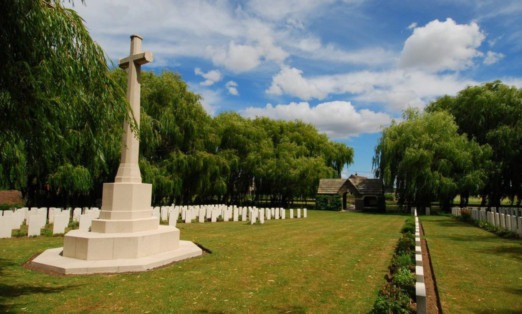A MODERN memorial to an Angus soldier and his First World War comrades is now in place, hundreds of miles from their homes.
The story of the young 5th Battalion Black Watch soldier Lance Corporal John McHardie Beaton, who served and died in France, has found a permanent home.
Kirriemuir resident Mr Beaton died aged 21 on May 9 1915 and a multimedia memorial is now in place at Le Trou-Aid-Post Cemetery, Fleurbaix.
The Commonwealth War Graves Commission became aware of Mr Beaton’s story and was keen to include him in a WW1 Remembrance Trail being prepared for 1914, the 100th anniversary of the war’s commencement.
In August 2012, the commission embarked on its programme to install visitor information panels into approximately 500 of its First World War cemeteries and memorials.
These will be spread across France, the Mediterranean, northern Europe and Commonwealth graveyards.
Ian Small of the commission said: “The aim of the programme is to provide visitors with the background as to why the cemetery or memorial is located there, details of the battle, and through personal stories accessed via a quick response code.
“This is to present a human side to those who are buried or commemorated there. The programme forms an integral part of our 1914-18 project.
“It’s hoped it will do much to improve awareness of our work and, with the support of the Commission’s Remembrance Trails, the presence of sites that are less frequently visited.”
Mr Beaton’s grave is marked as grave 20 in Row E.
The presentation is activated by using a modern phone by the memorial, but an online equivalent can be found on the CWGC website.
An updated account of the developments researched by social history enthusiast Helen Humphreys can be found on the website westmuir.org.uk.
Teams from France and northern Europe met at Gorre British and Indian Cemetery to commence the programme and to work with the supplier Symbius on installation techniques.
Further installations are planned for the Mediterranean and UK areas in September.
In 1914, British soldiers serving in the Fleurbaix sector began burying their fallen comrades beside a regimental aid post and dressing station located not far from the support trenches that led to the front line.
The cemetery is now the final resting place of officers and men killed in heavy fighting at Le Maisnil in October 1914, the Battle of Aubers Ridge (May 9-10, 1915), the Battle of Loos (September 25 October 14, 1915), and the Battle of Fromelles (July 19-20 1916).
Its features and landscaping were designed by Sir Herbert Baker, the British architect who also designed the Indian Memorial at Neuve Chapelle.
Some 883 Black Watch soldiers were killed among the 11,000 British casualties sustained on the day of Mr Beaton’s death, the vast majority within yards of their own frontline trench.
Mile for mile, the Battle of Aubers had among the highest casualty rates during the war and was an unmitigated disaster for the British Army.
General Douglas Haig was still learning how to launch offensives against the heavily-entrenched Germans.
Having lost so many men during the push for Aubers Ridge, after a 40-minute light bombardment over a wide front against strong defences, he would later concentrate on using massed artillery to inflict the bulk of enemy casualties.
riwatt@thecourier.co.uk
